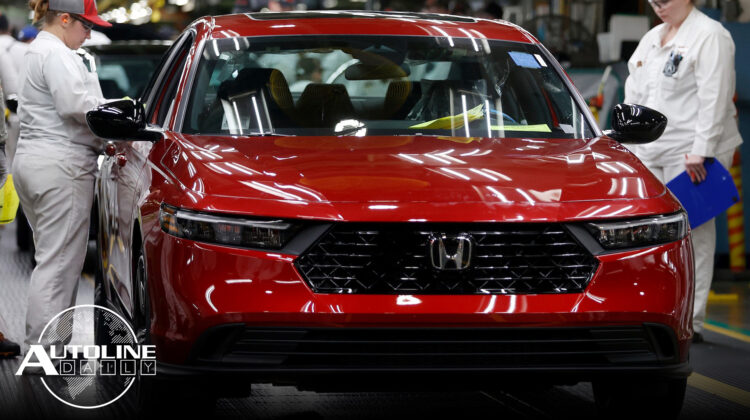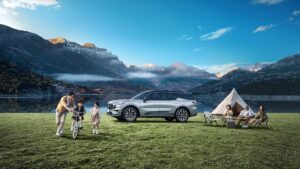
Follow us on social media:
Runtime: 10:49
0:00 Honda Standardizing ICE Lineups & Powertrains
2:17 Hertz Pulls Back EV Expansion
3:28 Stellantis Says It Was Least Affected by Strikes
4:32 Mercedes Bringing ChatGPT to Employees
5:05 New EV Truck Brand Close to U.S. Sales
5:44 Toyota Boosts EV Battery Production
6:24 Ford Expands Its Charging Network
7:08 Geely & Baidu Launch Affordable AV Tech
8:10 A Couple of Unique Sightings Around Detroit
Visit our sponsors to thank them for their support of Autoline Daily: Bridgestone, BorgWarner, Intrepid Control Systems and Schaeffler.
This is Autoline Daily, the show dedicated to enthusiasts of the global automotive industry.
HONDA STANDARDIZING ICE LINEUPS & POWERTRAINS
Honda made some really impressive gains in manufacturing efficiency last fiscal year and it’s poised to keep the momentum going. It says the break-even point for production capacity improved from about 90% to roughly 80%, which means it can build 10% fewer cars and still make the same amount of money. Honda’s also accelerating the standardisation of its ICE lineups and powertrain options and says it will migrate nameplates, like CR-V and Accord, to a new modular platform that supports both ICE and hybrid setups. But to keep them competitive, they will get the same or similar state-of-the-art features as EVs, including advanced safety tech. Speaking of Honda’s EVs, it’s launching the e:Ny1 in Europe very soon as well as several EVs in China, an electric kei van in Japan and the Prologue and the Acura ZDX in North America next year. Those last two are from its partnership with GM and Honda says collaboration on EVs is essential to its future and it’s trying to make it easier within the company to work with others. Areas it plans to partner include charging technology, software, digital services and batteries. The EVs it starts launching in North America in 2025, which will be built on a new dedicated EV platform from Honda, will be the first to feature its new operating system. By 2030, Honda thinks about 40% of its total sales will be electric and fuel cell vehicles and after plant retoolings it will make 2 million EVs a year by the same time. By 2040 it expects 100% of sales to be EVs and fuel cells. To help realise those goals, Honda is bringing its EV operations together more, establishing the Electrification Business Development Operations and hopes to be completely self-sufficient in the EV business by 2030.
HERTZ PULLS BACK EV EXPANSION
Rental car company Hertz is pulling back on its EV expansion. It no longer plans for a quarter of its fleet to be EVs by the end of the year and has slowed down the pace at which it’s adding EVs. Hertz previously said it would buy 100,000 Teslas and 175,000 EVs from GM, but right now it only has about 50,000 EVs in its fleet, 80% of which are Teslas. To be fair it says it’s still committed to buying the remaining EVs, just not as quickly. One of the more interesting reasons for the EV pullback is higher than expected repair costs. It’s not general maintenance stuff. That’s still cheaper for EVs. It’s the collision and damage repair costs, which Hertz says can often be double what the same repair would be on an ICE car. The other main reason for the EV pullback is lowering residual values. Since 80% of its EV fleet are Teslas and Tesla has been the most aggressive with its price cuts, the value of its EV fleet has gone down considerably.
STELLANTIS SAYS IT WAS LEAST AFFECTED BY STRIKES
The UAW and Unifor strikes cost Stellantis more than $3 billion in revenue. But the company says it was the least affected of the Detroit automakers and the strikes only cut $795 million from its operating profits. The automaker sold 1.48 million vehicles globally in the third quarter, up 11% from a year ago. And its BEV sales were up 37%. That helped boost its revenue 7% to nearly $48 billion in Q3. And despite the dent the strikes put in its revenue, Stellantis maintained its full-year guidance for a double-digit margin on its operating profit.
MERCEDES BRINGING CHATGPT TO EMPLOYEES
Mercedes isn’t just bringing AI into its cars, but it’s also applying the tech inside the company. Mercedes is launching a ChatGPT function for employees so they can work more efficiently. For example, it says they could use it to help make e-mails, reports and other work documents, or even summarise longer texts. It will first be available in English and German and Mercedes says most of its workforce will be able to use the ChatGPT feature by the end of the year.
Mercedes-Benz Direct Chat: an internal ChatGPT application for employees
NEW EV TRUCK BRAND CLOSE TO U.S. SALES
RIZON, which is the new division formed by Daimler Truck to sell all-electric Class 4 and 5 trucks in the U.S., has achieved full homologation for the market. That’s one of the last steps before it can start selling its trucks, which are really just rebadged versions of the FUSO eCanter. They will offer lithium-iron phosphate or LFP batteries in two sizes that provide between 110-160 miles of range. RIZON trucks will be sold exclusively through the Velocity Group, which has about 80 stores worldwide.
RIZON truck with stake bed for landscaping tasks
TOYOTA BOOSTS EV BATTERY PRODUCTION
Toyota is significantly boosting its investment in EV battery production in the U.S. The automaker is investing an additional $8 billion to build more batteries at a new factory it’s building in North Carolina. That brings the total investment to $13.9 billion, which will create 5,000 new jobs. Toyota is adding an additional eight BEV and PHEV battery production lines to the two that were previously announced. Production is expected to start in 2025 and it will eventually build up to a capacity of 30GWh a year by 2030.
FORD EXPANDS CHARGING NETWORK
Ford is expanding the number of Tesla Superchargers its customers will have access to in North America. It was originally 12,000 Superchargers but Ford increased it to more than 15,000. Ford EV customers will gain access to the Superchargers next year but no pricing has been announced yet. Ford also revealed that it has added three more charging providers to its BlueOval Charge Network in North America; Francis Energy, Blink and Red E. They’ll add 10,000 more chargers to the network, which puts its total at more than 106,000, including 11,800 fast chargers.
GEELY & BAIDU LAUNCH AFFORDABLE AV TECH
Geely and Chinese tech company Baidu unveiled the first vehicle from their joint venture. It’s an electric crossover called the Jiyue 01. What’s unique about this vehicle is its equipped with Baidu’s Apollo autonomous platform. The system features 11 HD cameras, 12 ultrasonic radars and five-millimeter wave radars. It’s capable of point-to-point navigation, auto lane changes and handling highway on and off ramp maneuvers. There are two battery sizes available, a 71.4-kWh pack that provides 550 kilometers or 342 miles of range and a 100-kWh pack that provides 720 kilometers or 447 miles. Both of those numbers are based on the Chinese test cycle. And despite all the tech, the model is relatively affordable with a starting price around $35,000.
A COUPLE OF UNIQUE SIGHTINGS AROUND DETROIT
I’ve had a couple of sightings in the Detroit area recently that you might be interested in. First I’ve seen several versions of the new Oshkosh mail truck driving around town. Yes, it looks just like it does in the pictures, but it’s nice to see them moving around on their own power. Last year I saw one on the back of a flatbed and it was a very early prototype. I could even see a bare piece of 2X4 being used to support the front fender. But with driving examples Oshkosh might be on track to hit its delivery start in June of next year. The other vehicle I’ve seen several times now is the Ford Edge L, which is only available in China. We have no news to report on this but it’s interesting to see that vehicle being tested in the U.S. For reference, the Edge L, is a three row SUV with a 2.0L EcoBoost engine that’s available as gas-only or hybrid.
But that brings us to the end of today’s show. Thanks for making Autoline a part of your day.
Thanks to our partner for embedding Autoline Daily on its website: WardsAuto.com










Any accident that damages the battery has to be a total.
Hum! Hertz pulling back on the amount of EVs it offers. So maybe those mega-castings are proving to be really expensive to repair? Plus, I just read an article that many dealerships don’t want anything to do with a used EV. The ones they do take in, go to auction, so the resale value is dropping. Making these cars look more like disposable vehicles.
Even the charging set up exudes a long visit. You park face into the charger (because you’ll be there a while), unlike gas which is quick enough you park next to so you can pull on through.
Since Sean brought up the Oshkosh mail truck. Still really disappointed that they are gas. If our government really wants us to be driving EV’s then why did, they approve a 10-year contract to buy these horrible MPG trucks? They will have a whole new fleet of mostly gas mail trucks by 2033 two years before they ban ICE. So, we are supposed to take them seriously?
Maybe people are crashing those Hertz Teslas because they can’t use the controls and look where they are driving at the same time.
Ford must be really confident that pickup trucks will be the hot sellers in the US market forever. First, they dropped all of their cars except Mustang. Now, they are dropping the crossovers, with Escape and Edge soon to be gone.
Postmaster General Louis DeJoy loves the gas hog mail trucks. They could at least use hybrid powertrains in the trucks. Ford is the powertrain supplier to Oshkosh, and using the powertrain from Escape hybrid would probably double mpg in typical mail truck use, with all of those starts and stops.
There are always unique vehicles driving around when we go up north through Michigan. A year ago we saw Sandy Munroe driving a white Chi ese suv! A black Lyriq with manufacturer plates was the first I have seen.
Y’all need to Google the latest articles on the postal fleet. The original contract included 10% EVs. That % has been increased twice since the contract was inked. Biden’s big green bill included another chunk of cash for even more postal EVs. They have already inked near-term purchases of Ford Transit EVs and charging stations to get the ball rolling while Oshkosh works to shift their production plan to a much heavier EV mix.
From a Dec 22 article: It’s part of the agency’s plans, announced in December, to make 75% of its newly acquired vehicles, known as Next Generation Delivery Vehicles, over the next five years electric. After 2026, NGDV purchases will be 100% electric, the agency said.
I think we are getting to the point where we can all stop using range anxiety as a reason people won’t buy EVs. (Of course, there are other reasons). In just the Ford network, Sean reports they will have 106,000 public chargers available by January. That is an average of 2,120 per state. And that is just in the Ford network. The number and geographic breadth of chargers means that an EV owner can travel beyond their local area with confidence. I think the EV sales rate will continue to climb and even accelerate as some of the less expensive models hit the market, like the Chevy Equinox EV, among others.
Not sure why insurance companies are not forcing the total losses as auction prices for salvage EV’s are through thr roof! Watching bidders from all over the world buy U.S. based wrecked EV’s I can only think th3y are repurposing the batteries for energy storage by dismantling and creating storage cabinets of EV batteries with their custom made BMS(battery management systems.
At the 7:35 mark, it looks like the electric Jiyue 01 has an exhaust tailpipe. I am guessing it is probably something on the floor of the dealership that hooks up to the exhaust of an ICE. It looks to have a black plug blocking the tube, but does anyone have any insight as to what that really is?
The Ford Blue Oval charging network is impressive.
Only the few sparsely populated upper northern state are not well covered.
Cross country trips are not difficult anymore with planning.
However the types of charging and range per unit of time could be confusing to the average person who is not well versed in electrical terms.
The 5 options are:
120V 12 AMP________3 Miles of Range per HR.
240V 30AMP________ 20 Miles of Range per HR
48 AMP ____________ 28 Miles of Range per HR
80 AMP ____________ 28 Miles of Range per HR
150 KW DC Max______ 59 Miles of Range per 10 Min
So much easier with Regular or Premium Gas with the price per gal. on the pump.
@Lew: for me only the last category, 150 kW (59 miles of range per 10 minutes) would when I would have to charge during a long distance road trip.
My wife and I drove from Detroit to Chicago with her Mustang Mach-E when she just had it, to try it out. We were not yet knowledgeable about how to find the right charging stations. So we ended up at the casino close to Battle Creek when the battery was low. Charging was free, but it was a low power charger, so a full charge would have taken 8 hours. We left to find a fast charger because we figured that a few hours at the casino while waiting for the battery to charge would cost a lot more than paying for the electrical power.
* would work when
what happened to the new editing feature when I need it?
@ Wim van Acker, you get 10 minutes from the time you originally post. Edit goes away after that.
@Wim van Acker
Missing word was understood.
Editing feature worked for me, used it several times.
Wise man to leave the One Armed Bandit charging station.
@ChuckGrenci I saw the mistake immediately after I posted but the feature was not available. I know how to use it because I often find a mistake or two after I posted 🙂
And now it is working, because this sentence is an edit.
Wim, it sounds like that casino has a system, providing free charging, while you donate a few hundred dollars in the casino.
Even 59 miles/10 minutes with the 150 kW DC charging would not be as fast as I’d want on a long highway trip. I like getting 400-500 miles in 5 minutes. It sounds like there are a lot of chargers out there, but you have to look for them, presumably using a phone app. I almost never see any chargers when I’m just driving around, but there’s a gas station every few hundred feet.
Edit wasn’t working earlier, but now it is. I just added this sentence.
@Kit We were new to using public chargers and could not get it done once we had found one. It was a Saturday and our son was available to explain to the Flintstones (my wife and me) through Facetime how to set up our credit card with the charger system for the first time.
GM Vet, I’d agree that charging or range anxiety isn’t really the reason behind the lack of EV adoption. I truly believe the price has been the real hold up and we are just now starting to see some affordable options. Each manufacturer has teased the public with these $39,000 prices that never materialized. And they don’t miss the target just a little. The Ford lightning Pro base is 10K more at 49,000. XLT is 55K the Lariat starts at 60K and the Platinum starts at 92K. Even a Tesla base model 3 which is about the same size and features as a Toyota corolla starts at $38,990 before any credits. Meanwhile the Toyota starts at $21,900.
Inflation is out of control and people are just not willing to spend an extra $17,000 for a car that has less range and is going to save them maybe $500-700 a year in fuel. (BTW that’s a 24-34 year pay back.)
Even if you charged for free all the time you still only save $1500 a year which is still a 11.3 year payback with gas at $3.50 a gallon.
Its just a hard sell for most people and until they can get prices on par with ICE I believe it will remain a hard sell. Typically to sell something you need to offer some advantage and EV’s only offer quiet and environmentally friendly. EV’s are less convenient and so they should be cheaper. People will sacrifice some convenience to save money but they won’t spend more and deal with less.
Wim, convenient that you had help with setting up the charging.
Lambo, price is a factor with some people, but is not a big factor in what millions of people buy. Look around at what’s on the road. Lack of home charging, lack of convenience with public charging, charge time compared to filling a gas tank, (mostly invalid) scares about fires, are a few of the reasons more people haven’t bought EVs. Part of what people like about EVs is that they are quick. Granted, any vehicle now sold in the US is “quick enough,” but quicker is more fun, and better for overtaking on two lane roads.
It’s too early to really know how EVs will hold their value, long term. Teslas bought before all of the price cuts have certainly depreciated a lot, but those bought now might not. Again, it’s too early to know, but IF batteries start failing in large numbers after, say, 12-15 years, regardless of miles, EVs will have a big drop off in value at some point in time.
@Lambo “Inflation out of control”? The facts: annualized monthly inflation figures have come down from 7.7% in October 2022 to 3.7% in September 2023; June 23 3.0%, July 3.2% and August 3.7%. So not out of control.
There seems to be a Cybertruck version in the works, that will purportedly be capable of accelerating to 60mph in under 3 seconds. I’m thinking this kind of purchase should require proof of having participated in a number of races on actual racetracks. (I really dislike blanket prohibitions.)
Wim van Acker;
You can trust those numbers from where-ever you got them as the government and compliant media prepare for an election year by downplaying the actual inflation. But here are some actual numbers with sources. I bought my house in 2020 and have an interest rate of 2.85% right now a good rate is 7.25%. To buy my home today would cost 35% more. Every fast-food joint has increased their meals from $6-7 to $10-12, Thats a 60% increase.
The average cost of a car in 2019 was $36,719 in 2023 its $48,008 that’s a 30.7% increase. (according to Edmunds)
The average home in the US in 2019 was $247,084, and in 2023 its $370,754 Thats a 50% increase (according to Business insider)
Average monthly food for three was $622.91 in 2019 and is now $902 which is a 44.8% increase. (according to Dept of labor and statistics).
So, you can be told it’s not that bad and believe it or just look around what you pay for things and google what that cost just 4 years ago, and you can quickly see that yes inflation is far greater than we are being told.
Minimum wage has been $7.25 since 2009 which is worth about $6.15 in 2023. about $1.10 less. So minimum wage should be about $8.35 today yet many places are paying $15-20 an hour. Any guess why that is? Any guess how that will affect the cost of living? So even though legit government web sites show the COLA increase at a mild 3% that’s not what I’m seeing in my day to day purchases. So rather than take their number at face value just check the prices of almost any item from now and 4 years ago. Then you see the real numbers.
Sean W
I agree that these very quick EV’s will create some problems. Having owned a sports bike that is capable of 0-60 times in the 3.3 second range one of the most dangerous things you can do is take off from a light in town at full throttle. Those bikes are so quick and its deceiving to other motorists. One second your stopped at a light and another driver maybe across the intersection looks, and actually see’s you but your stopped. So, they start to pull out into traffic, 3 seconds later you can be doing 60 mph while they are still 10 mph into their rear bumper. Or worse someone pulling into the gas station from the left turn lane, and you broadside them.
I anticipate lots of accidents like this as most drivers will look and think they have a normal amount of time to pull out, but these super quick EVs will close that gap way too quickly. It’s not like when you notice a vehicle traveling too fast and you can adjust the time you need to cross their path. This is from a dead stop, so you have no idea the time you have until they are already going 60mph.
I loved the speed and acceleration of my bike but that was the quickest way to crash.
Lambo, interest rates are still low. When I bought a house in 1980, my mortgage was 12%. A lot of why “car” prices have increased that much is because the D3 have quit selling cars, and the SUVs and trucks being sold instead cost more than cars.
Kit they stopped selling cars before 2019. You may think 7.25% is low but on that average price of a home of $370,754 on a 30 year fixed rate the monthly payment changes from $1533.28 at 2.85% to 2529 when its 7.25% basically a $1000 a month difference. Thats a lot.
As for my stance on EVs being too expensive here is a great article I just found today.
https://www.msn.com/en-us/money/markets/evs-were-supposed-to-be-the-answer-now-they-re-the-problem/ar-AA1j9zxq?ocid=hpmsn&cvid=753de40a72bb45c791ddfb3918365e24&ei=84
Lambo, indeed. It’s just another world. And those trucks will weigh around 3 tons. By the time a driver unaccustomed to that kind of speeding potential reacts, it can be too late.
Ideally, Tesla would take that into account, and make some kind of familiarization ride mandatory of their own volition.
Lambo, Cruze, Impala, and Lacrosse were around through 2019 model year, and Fusion through 2020. Also, more people are buying luxury vehicles and expensive trucks and SUVs rather than Corollas, Accords and Camrys by choice.
If you buy the same car, the price has not increased nearly as much as the “average” price increase. A 2019 Camry LE had an MSRP of $24,350. A 2023 is $26,320. That’s an 8% increase, and the 2023 probably has more standard safety gadgets. Yes, if you replace a Camry with a Lexus RX, that contributes to a big increase in “average” car price.